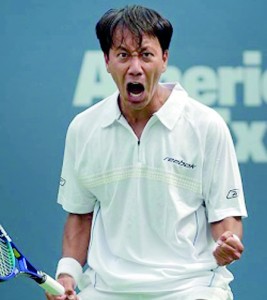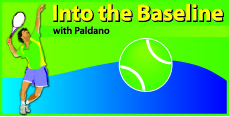The winning road and the comfort zone
View(s):Impressive players win easily. Exceptionally unimpressive players with unusual styles have dominated the world of tennis. This is not rare either.
Michael Chang of USA won the French Open with a difficult game and he even served under arm. Françoise Durr, a French female player had a backhand that could have broken her wrist anytime. Berger, a German, had a service that no coach will claim to have taught. The legendary Alvarez of South America was a unique racquet handler but he even beat Rod Laver. Ramanathan Krishnan of India was a touch artist with minimum arm movement and he reached the Wimbledon semifinals. All of them were very effective. How did they do it?
COMFORT-ZONE

USA’s Michael Chang is a player who overcame a number of tough situations to win many international titles.
The Comfort Zone is the answer. Regardless of how they looked to others, effective players stayed within their comfort-zone. They developed strong personality, lasted longer and went further. Why does no one talk about it? Forcing effective players to be technical can destroy their comfort-zone.
INDIVIDUALISM
The label of Individualism arises from the comfort zone of players. With their comfort zone they can handle extreme situations. Strength of performance is in the individual’s comfort zone. Even today it remains underutilized and unrecognized. Players who are self taught and develop with competition have better comfort-zones. Comfort to perform mostly comes from the ‘form follows function’ path in development. It being game oriented the focus falls on ‘functional- strokes’ and leads players to have good comfort-zone.
NATURAL RHYTHM IS INSTINCT
What does SIGHTING do? – It tracks the ball, engages the mind and initiates reaction. When it is continuous we are in rhythm with the ball movement. In a rally, regardless of the number of shots, if we sight the ball continuously, 100% of the time our reactions will be in coordination with the match rhythm. Reaction is instinctive when the information flow is continuous.
Comfort zones address close up blind spots, sharp focus areas, field of vision for target selection, timing of reaction and positioning. All of these are tactical. It is a simple aspect to understand but continuous application is a formidable task under match pressure. A clue: semi-open foot stances in ground strokes and open in volley helps sighting to be continuous.
How do we use our body? Footwork gives body position; body position gives coordination, comfort in coordination gives the arms better racquet-handling possibilities and leads to good contact timing. Treat these as a single entity, no breakdown please.
Here is a quiz to earn fifty bucks from a tennis friend. Ask him/her on which side of the body the backhand is played? If a right-hander says the left-hand side, you have won fifty bucks. Both contact points for a right-hander are on the right-hand side of his body. The forehand uses the front muscles to swing the arm into the body [angular] to meet the ball on the right-hand side. The backhand uses the back muscles to swing the arm away from the body to meet the ball also on the right side.
OPEN AND SEMI-OPEN FOOT STANCE
Bio-mechanically the backhand has better body support being behind the contact. Body position is an obstruction for the forehand. Open and semi-open stances of forehand came to being to overcome this disadvantage. Semi-open provides the best balance and power on both sides. If you are uncomfortable with your ground strokes try others, you may fall into better comfort-zone. There are others but the next is the decider
THE DECIDER: ALL IMPORTANT BALANCE
As individuals why do we move and do things different? We balance ourselves differently, that is the reason. Body balance is priority number one, not stroke-making. Instinct, that’s what balances our body and it overrides all other functions to achieve this. Balance needs sight, speed and power to act. The reaction chain breaks when balance is disturbed, balance can be static or dynamic. Good balance means a good comfort zone; it is the winning road.
CONTAMINATION
Some unwanted aspects reduce our comfort zone. For coach, Paul Dale, A New Zealander living in Thailand, this is a top priority. He diligently identifies and removes contamination from his players. Some of the best Thai players from the last twenty years are his. A pure player appears when contamination is removed. I endorse his view completely. Nothing is more true and rewarding in competitive tennis than elimination of the unnecessary. Good players work in a tight micro second time frame where the flow of reaction is the line-of-life. If the style and reactions are contaminated, a player will be out of the comfort zone and enter the disaster-zone. Contamination works against you.
GOOD NEWS
Comfort-zone can be developed at any level and at all ages, even after many years of play. Turn your head towards it and make the nature’s gifts work for you to be a better tennis player. Increase your comfort zone; it reduces risk of injury, improves the game and will give an opportunity to explore new areas. It is the winning road. You could be in the grand slam finals! – Good luck- georgepaldano@yahoo.com-
Follow @timesonlinelk
comments powered by Disqus
















